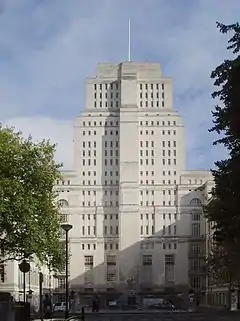London School of Hygiene & Tropical Medicine
The London School of Hygiene & Tropical Medicine (LSHTM) is a public research university in Bloomsbury, Camden, and a constituent college of the University of London that specialises in public health and tropical medicine.
 | |
| Type | Public |
|---|---|
| Established | 1899 – London School of Tropical Medicine 1924 – London School of Hygiene & Tropical Medicine established by Royal Charter |
| Founder | Sir Patrick Manson |
Parent institution | University of London |
| Endowment | £17.5 million (2019-20)[1] |
| Budget | £242.9 million (2019–20)[1] |
| Chancellor | The Princess Royal (University of London) |
| Director | Baron Peter Piot |
Academic staff | 852 (London, 2019-20)[1] |
Administrative staff | 600 (London, 2019-20)[1] 1,832 (MRC Units Gambia and Uganda, 2019-20)[1] |
| Students | 1,279 (2019-20)[1] |
| Location | Bloomsbury, London, England, United Kingdom |
| Campus | Urban |
| Website | www |
The institution was founded in 1899 by Sir Patrick Manson, after a donation from the Indian Parsi philanthropist B. D. Petit. Since its foundation it has become one of the most highly placed institutions in global rankings in the fields of public health and infectious diseases.[2][3][4][5][6]
The annual income of the institution for 2019–20 was £242.9 million, of which £168.5 million was from research grants and contracts, with expenditures totalling £219.8 million during the same period.[1]
History
Origins
.jpg.webp)
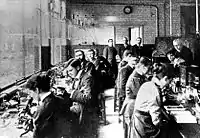
The school was founded on October 2nd, 1899 by Sir Patrick Manson as the London School of Tropical Medicine after the Parsi philanthropist Bomanjee Dinshaw Petit made a donation of £6,666.[7][8]
It was initially located at the Albert Dock Seamen's Hospital in the London Docklands.[9] Just prior to this teaching in tropical medicine had been commenced in 1899 at the Extramural school at Edinburgh and even earlier at London's Livingstone College founded in 1893 by Charles F. Harford-Battersby (1865–1925). Before giving lectures at St George's Hospital, London, in 1895, Livingstone College afforded Manson his first opportunity to teach courses in tropical medicine.[10] Manson's early career was as a physician in the Far East where he deduced the correct etiology of filariasis, a parasitic vector based disease, transmitted through the bite of a mosquito. On his return to London, he was appointed Medical Advisor to the Colonial Office. He strongly believed that physicians should be trained in tropical medicine to treat British colonial administrators and others working throughout Britain's tropical empire. He also encouraged and mentored Ronald Ross during this period to uncover the correct etiology of malaria, which Ross subsequently discovered in 1897, winning the Nobel Prize for his efforts. The original school was established as part of the Seamen's Hospital Society.
In 1902, the benefactor Petit wrote the following about the institution in a letter to Sir Francis Lovell (Dean of the School), quoted in The Times.
This institution, whilst according ample scope to students of diseases that well nigh devastate the East, will be the means of bringing the Western and Eastern minds together to afford help to the suffering East, and thus cementing that union of hearts.[11]
Among the School's early achievements were discoveries by George Carmichael Low, who proved filariasis is spread by mosquito bites, and Aldo Castellani, who discovered trypanosomes in the cerebral fluid of those affected by sleeping sickness. Experiments were also conducted by the School's faculty which provided proof that mosquitoes act as the vector in the spread of malaria.[12]
World Wars
During World War I, many of the faculty were conscripted into the army where they often continued to treat or research tropical diseases with the aim of protecting the health of the troops fighting in the Middle Eastern and African campaigns. Meanwhile, enough faculty remained at the School to continue its operations, although enrollment drastically fell during the war. The remaining faculty contributed to the war effort nonetheless by becoming increasingly involved in treating soldiers suffering from dysentery, malaria, and other tropical diseases after their return from overseas. On the night of January 19, 1917 a TNT explosion from a nearby munition depot damaged the school and hospital, further complicating the School's operations. The School's wartime contributions were acknowledged on October 10, 1917 by a surprise visit from King George V and in 1918 by a visit from Queen Mary, Prince Edward, and Princess Mary.[12][8]
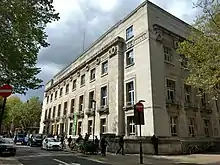
As a result of the war, the School expected an increase in the amount of patients suffering from tropical diseases and so a resolution was proposed to move the School to Central London to improve upon the School's isolated location.[12][8] Consequently, the School moved, together with the Hospital for Tropical Diseases, to Endsleigh Gardens in central London, taking over a former hotel which had been used as a hospital for officers during the First World War.[13] The building was officially opened by George VI, then Duke of York, on 11 November 1920.[12] In 1921 the Athlone Committee recommended the creation of an institute of state medicine, which built on a proposal by the Rockefeller Foundation to develop a London-based institution that would lead the world in the promotion of public health and tropical medicine. This enlarged school, now named the London School of Hygiene & Tropical Medicine was granted its Royal Charter in 1924.[12] The School moved to the current building in 1929.
The School remained at its location in London during World War II despite the risk of bombings and an offer for accommodation by Queens' College, Cambridge. The number of students and staff fell as a result of the war, with some staff being called upon for military service. After 1941 and continuing until the end of the war, regular instruction ceased and the School instead started providing short courses in tropical medicine to nurses and doctors of the Allied Forces. On 10 May 1941, a bomb struck the building and caused a fire which was only put out the following morning due to a lack of firemen. Only four people were present at the time and remained unharmed, however, around a sixth of the building was damaged, with particularly the side facing Malet Street sustaining extensive damage. Although the damage was only fully repaired seven years later, teaching of short courses resumed the Monday after the bombing.[8][12][14]
Campus
The school moved to its present location near the intersection of Gower Street and Keppel Street in 1929. A competition to design a new school building to be sited in Gower Street, was held involving five architects, all experienced in laboratory design and construction. This was won in 1925 by Morley Horder and Verner Rees who located the main entrance in Keppel Street. The foundation stone was laid in 1926 by Neville Chamberlain, then Minister of Health, and the completed building was opened in 1929 by Edward VIII, who was the Prince of Wales at that time.[12] The purchase of the site and the cost of a new building was made possible through a gift of $2m from the Rockefeller Foundation.[15] The school also has a secondary site on Tavistock Place to the east.
Academics
Faculty of Epidemiology and Population Health
The Faculty of Epidemiology and Population Health aims to be a methodological centre of excellence for research in national and global health issues, to expand the limits of epidemiological thinking & multi-disciplinary research to further understanding of health issues in their full complexity, to develop, refine and disseminate tools & methods for research design, data collection, analysis and evaluation, and to conduct rigorous research in national and global health.
Faculty of Infectious and Tropical Diseases
The Faculty of Infectious and Tropical Diseases (ITD) was formed in August 1997 and encompasses all of the laboratory-based research in the School as well as that on the clinical and epidemiological aspects of infectious and tropical diseases. It is currently headed by Simon Croft, who is Professor of Parasitology. The Faculty is organised into four large research departments. The range of disciplines represented in the faculty is very broad and inter-disciplinary research is a feature of much of its activity.
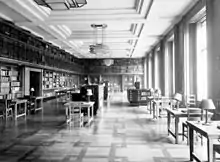
The spectrum of diseases studied is wide and there are major research groups working on topics which include:
- HIV/AIDS and other sexually transmitted diseases
- malaria and other vector borne diseases
- tuberculosis
- vaccine development and evaluation
- vector biology and disease control
There is close interaction between scientists in different research teams. The Faculty has overseas links which provide a basis for field studies and international collaborations in developed and developing countries. Funding for research in the Faculty comes from around 45 funding organisations and agencies.
Faculty of Public Health and Policy
The Faculty of Public Health and Policy aims to improve global health through research, teaching and the provision of advice in the areas of health policy, health systems and services, and individual, social and environmental influences on health. Interests and activities embrace the health needs of people living in countries at all levels of development. The School has the largest numbers of research active staff in the areas of epidemiology, public health and health services research in the UK.[17] The Faculty of Public Health and Policy has over 220 members of staff, including epidemiologists, public health physicians, economists, policy analysts, anthropologists, sociologists, historians, psychologists, statisticians and mathematicians. The Faculty's research programmes, with an annual spend of over £7m, focus on public health problems of importance both globally and in the UK, and build on an extensive network of collaborations.[18]
The research programmes exploit multidisciplinary and multi-method approaches, generate new knowledge for specific contexts and test transferability to different settings, and engage with policymakers and providers of health care to ensure research is relevant and translated into practice.
The Faculty hosts School Centres in the areas of History in Public Health,[19] Research on Drugs and Health Behaviours, Spatial Analysis in Public Health, Global Change and Health, Health of Societies in Transition (ECOHOST), and Gender Violence and Health. In addition, staff participate in Centres based in other departments, notably the Malaria Centre and the Centre for the Mathematical Modelling of Infectious Disease.
Research centres
_-_LSHTM.JPG.webp)
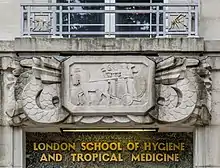
The School is currently home to the following research centres:
- Antimicrobial Resistance Centre
- Centre for Global Chronic Conditions
- Centre for Global Mental Health
- Maternal Adolescent Reproductive & Child Health (MARCH)
- Malaria Centre
- Centre for Evaluation
- Centre for Statistical Methodology
- TB Centre
- Health in Humanitarian Crises Centre
- The Applied Genomics Centre
- Centre for the Mathematical Modelling of Infectious Diseases
- Centre for History in Public Health
- The Vaccine Centre
- Centre on Climate Change and Planetary Health
Teaching and research programmes

All three Faculties offer a wide range of MSc courses and Research Degrees leading to a University of London degree of DrPH, MPhil and PhD. Courses are delivered both face-to-face in London and via distance learning in collaboration with the University of London International Programmes. The School also offers access to free online courses.
Awards
The LSHTM won the 2009 Gates Award for Global Health established by the Bill & Melinda Gates Foundation and received $1 million in prize money.[20] The award recognises organisations that have made an outstanding contribution to improving global health.
More recently, a team of researchers led by Richard Hayes at the London School of Hygiene & Tropical Medicine, have been awarded $37 million to test an innovative combination of strategies to prevent HIV in African countries.
Donald Reid Medal
The Donald Reid Medal is awarded triennially by the LSHTM in recognition of distinguished contributions to epidemiology.[21]
Rankings
| University rankings | |
|---|---|
| Global – Overall | |
| ARWU World[22] | 201-300 (2020) |
| CWTS World[23] | 23 (2020) |
| THE Reputation[24] | 126-150 (2020) |
| USNWR Global[25] | 114 (2021) |
In 2008, the UK Research Assessment Exercise (RAE) confirmed the School as a world leading centre for research. The School has been ranked one of the top three research institutions in the UK in the Times Higher Education Table of Excellence, which is based on the 2008 Research Assessment Exercise.
In the 2015 CWTS Leiden Ranking, the LSHTM ranked as the top university in Europe for research impact in all fields, ahead of Oxford and Cambridge.[26] The School was also ranked 6th overall in the world for impact based on the top 1% of published papers in all fields, after MIT, Harvard, Caltech, Stanford and Berkeley, 3rd in the world for biomedical and health sciences, after only MIT and Caltech, and 5th in the world overall for collaborative research.[26] By 2020 the School ranked 23rd.[23]
For the 2021 US News Best Global Universities Rankings, LSHTM ranked 3rd in Public, Environmental and Occupational Health, 4th in Infectious Diseases, and 11th in the world for Social Sciences and Public Health.[2] The School also ranked 45th in the world for clinical medicine and 88th for cardiovascular systems, 26th for immunology and 46th for microbiology, contributing to an overall ranking of 114th in the world, 43rd in Europe and 12th in the UK.[2]
In the 2020 ARWU Ranking for the subject of Public Health, LSHTM ranked 3rd globally behind only Harvard University and Johns Hopkins University.[3]
Due to the absence of undergraduate degrees, LSHTM is not included in the overall university rankings of QS and Times Higher Education.[27][28]
Notable people
References
- "Financial Statements for the Year Ended 31 July 2020" (PDF). London School of Hygiene & Tropical Medicine. Retrieved 22 January 2021.
- "London School of Hygiene & Tropical Medicine - USNWR".
- "ShanghaiRanking's Global Ranking of Academic Subjects 2020 - Public Health | Shanghai Ranking - 2020". www.shanghairanking.com. Retrieved 2 September 2020.
- "School ranked third globally for social sciences and public health by US News & World report | London School of Hygiene & Tropical Medicine | LSHTM". www.lshtm.ac.uk. Retrieved 27 April 2016.
- "Top Social Sciences and Public Health Universities in the World | US News Best Global Universities". www.usnews.com. Retrieved 27 April 2016.
- "School tops research league tables in 2015 Leiden Ranking | London School of Hygiene & Tropical Medicine | LSHTM". www.lshtm.ac.uk. Retrieved 27 April 2016.
- Medical Record – Volume 70 by George Frederick Shrady, Thomas Lathrop Stedman – 1906– Page 26
- Manson-Bahr, Sir Philip (1956). History of the School of Tropical Medicine in London, 1899–1949.
- Cook GC, Webb AJ (2001). "The Albert Dock Hospital, London: the original site (in 1899) of Tropical Medicine as a new discipline". Acta Trop. 79 (3): 249–55. doi:10.1016/S0001-706X(01)00127-9. PMID 11412810.
- Johnson, Ryan (1910) Colonial Mission and Imperial Tropical Medicine: Livingstone College, London, 1893–1914, Social History of Medicine Volume 23, Issue 3 Pp. 549–566
- "The London School of Tropical Medicine". The Times (36874). 16 September 1902. p. 7.
- "Historical timeline". LSHTM. Retrieved 25 October 2019.
- "Albert Dock Seamen's Hospital". AIM25.
- "75 Years Ago Today: LSHTM & the Blitz". LSHTM Library & Archives Service blog. 10 May 2016. Retrieved 5 February 2021.
- "London School of Hygiene & Tropical Medicine website, The History of the Building page". Archived from the original on 17 August 2016.
- "Library & Archives Service". LSHTM.
- RAE 2008
- LSHTM Annual Report 2008
- Centre for History in Public Health,London School of Hygiene and Tropical Medicine, http://history.lshtm.ac.uk/
- "2009 Gates Award for Global Health". Archived from the original on 25 January 2013. Retrieved 30 July 2009.
- London School of Hygiene and Tropical Medicine, Report on the Work of the School 1977–1978, page 21, 1978, (London:London School of Hygiene and Tropical Medicine)
- "London School of Hygiene & Tropical Medicine | Academic Ranking of World Universities - 2020 | Shanghai Ranking - 2020". www.shanghairanking.com.
- Studies (CWTS), Centre for Science and Technology. "CWTS Leiden Ranking". CWTS Leiden Ranking.
- "London School of Hygiene and Tropical Medicine". Times Higher Education (THE). 9 January 2021.
- "Best Global Universities".
- "School tops research league tables in 2015 Leiden Ranking | London School of Hygiene & Tropical Medicine | LSHTM". www.lshtm.ac.uk. Retrieved 27 April 2016.
- "World University Rankings – Frequently Asked Questions". Top Universities. 6 June 2018. Retrieved 2 September 2020.
- "THE World University Rankings 2020: methodology". Times Higher Education (THE). 2 September 2019. Retrieved 2 September 2020.
Further reading
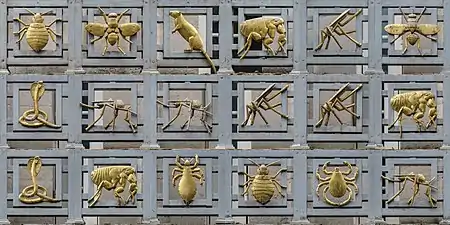
- Lise Wilkinson and Anne Hardy, Prevention and cure: the London School of Hygiene & Tropical Medicine: a 20th century quest for global public health, Kegan Paul Limited, 2001, ISBN 0-7103-0624-5
- G.D. Hale Carpenter joined the London School of Hygiene and Tropical Medicine, and took the DM in 1913 with a dissertation on the tsetse fly (Glossina palpalis) and sleeping sickness. He published: A Naturalist on Lake Victoria, with an Account of Sleeping Sickness and the Tse-tse Fly; 1920. T.F. Unwin Ltd, London; Biodiversity Archive
